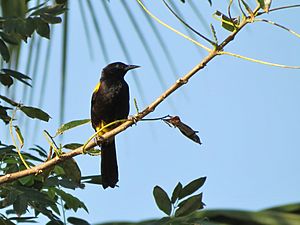Puerto Rican oriole facts for kids
Quick facts for kids Puerto Rican oriole |
|
|---|---|
 |
|
| Conservation status | |
| Scientific classification |
The Puerto Rican oriole (Icterus portoricensis) is a type of bird. It belongs to the Icteridae family, which includes many New World blackbirds. This bird is related to other orioles like the orchard oriole and the hooded oriole.
For a long time, the Puerto Rican oriole was thought to be the same species as the Cuban oriole, Hispaniolan oriole, and Bahama oriole. But in 2010, scientists decided that each of these was its own unique species. This decision was made by the American Ornithologists' Union.
Contents
Where the Puerto Rican Oriole Lives
This oriole is endemic to Puerto Rico. This means it is found only there and nowhere else in the world! Its favorite places to live are tropical forests, mangrove forests, and even plantations. These birds especially like to build their nests in palm trees.
How the Puerto Rican Oriole Behaves
After baby orioles hatch, the whole family stays together. The parents and their young will often stay in a group. These birds look for food in thick plants and trees. They eat many different things, including fruits, insects, lizards, nuts, and grains.
What the Puerto Rican Oriole Looks Like
Male and female Puerto Rican orioles look very similar in size and color. Males usually weigh about 41 grams, and females weigh around 36.6 grams. Their wingspan is also similar, with males averaging 96.9 millimeters and females 92.1 millimeters.
A study in 2008 showed that male and female Puerto Rican orioles have very similar bright colors. This is different from many birds in cooler parts of the world, where males are often brightly colored and females are duller.
Adult orioles are mostly black. They have bright yellow feathers on their lower belly and shoulders. Other related orioles, like the Hispaniolan oriole and Bahama oriole, have more yellow on their bodies. The Cuban oriole has more black.
Young orioles, called juveniles, are a tawny (brownish-orange) color with a hint of olive green on their back. They get their bright yellow and black colors as they grow older. This tawny color helps young birds hide in the dense forest, keeping them safe from predators. Scientists believe this color was likely the original color for all birds in the Icterus group.
How the Puerto Rican Oriole Communicates
Both male and female Puerto Rican orioles likely sing. People often think only male birds sing, especially in cooler climates. However, a study in 2009 found that both males and females of many tropical orioles sing. It is believed that the Puerto Rican oriole does this too.
The song of the Puerto Rican oriole sounds like clicks or "high-pitched whistles." Their songs have a frequency range between 3.6 and 5.3 kHz. Each bird combines between 15 and 27 different notes to create its unique song.
Reproduction and Life Cycle
Most birds in the oriole family are thought to be monogamous. This means they form a lifelong bond with one partner. The Puerto Rican oriole usually breeds from February through July.
Female orioles lay about three eggs at a time. The eggs are white with a bluish tint and have light lavender-gray-brown speckles and spots. These birds often build nests that hang loosely, usually suspended under palm trees.
See also
 In Spanish: Turpial puertorriqueño para niños
In Spanish: Turpial puertorriqueño para niños


